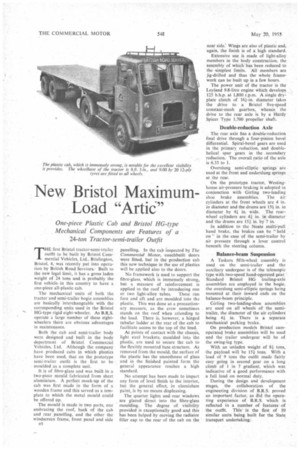New Bristol Maximum Load "Artie
Page 34

If you've noticed an error in this article please click here to report it so we can fix it.
One-piece Plastic Cab and Bristol HG-type Mechanical Components are Features of a 24-ton Tractor-semi-trailer Outfit
THE first Bristol tractor-semi-trailer outfit to be built by Bristol Corn-. mercial Vehicles, Ltd., Brislington, Bristol, 4, was recently put into operation by British Road Services.' Built to the new legal limit, it has a gross laden weight of 24 tons and is probably the first vehiclein this country to have a one-piece all-plastic cab.
The mechanical units of both the tractor and semi-trailer bogie assemblies are basically interchangeable with the corresponding units used in the Bristol — HG-type rigid eight-wheeler. As B.R.S. operate a large number of these eightwheelers there are obvious advantages in maintenance.
Both the cab and semi-trailer body were designed and built in the body department of Bristol Commercial Vehicles, Ltd. Although the company have produced cabs in which plastics have been used, that on the prototype semi-trailer outfit is the first to be moulded as a complete unit.
It is of fibre-glass and was built in a two-piece mould fabricated from sheet aluminium. A perfect mock-up of the cab was first made in the form of a wooden frame and this served as a template to which the metal mould could he offered up.
The mould is made in two parts, one embracing the roof, back of the cab and rear panelling, and the other the windscreen frame, front panel and side n3
panelling. In the cab inspected by The Commercial Motor, coachbuilt doors were fitted, but in the production cab this new technique in the use of plastics will be applied also to the doors.
No framework is used to support the fibre-glass, which is immensely strong, but a measure of reinforcement is applied to the roof by introducing one or two light-alloy tubes. These run fore and aft and are moulded into tbzi plastic, This was done as a precautionary measure, as the crew sometimes stands on the roof when attending to the load. There is, however, a hinged tubular ladder at the rear of the cab to facilitate access to the top of the load.
At points of contact with the chassis, light steel brackets, moulded into the plastic, are used to secure the cab to the flexibly mounted base structure. As removed from the mould, the surface of the plastic has the smoothness of glass and in the finished painted form the general appearance reaches a high standard.
No attempt has been made to impart any form of level finish to the interior, but the general effect, in aluminium paint, is by no means displeasing.
The quarter lights and-rear windows are glazed direct into the fibre-glass moulding. The degree of visibility provided is exceptionally good and this has been helped by moving the radiator filler cap to the rear of the cab on the near side. Wings are also of plastic and, again, the finish is of a high standard.
Extensive use is made of light-alloy members in the body construction, the assembly of which has been reduced to the simplest limits. All members are jig-drilled and thus the whole framework can be built up in a few hours.
The power unit of the tractor is the Leyland 9.8-litre engine which develops 125 b.h.p. at 1,800 r.p.m. A single dryplate clutch of 161-in, diameter takes the drive to a Bristol five-speed constant-mesh gearbox, whence the drive to the rear axle is by a Hardy Spicer Type 1,700 propeller shaft.
Double-reduction Axle
The rear axle has a double-reduction final drive through a four-pinion bevel differential. Spiral-bevel gears are used in the primary reduction, and doublehelical spur gears in the secondary reduction. The overall ratio of the axle is 6.33 to 1.
Overslung semi-elliptic springs are used at the front and underslung springs at the rear.
On the prototype tractor, Westinghouse air-pressure braking is adopted in conjunction with Girling two-leading shoe brake assemblies. The air cylinders at the front wheels are 4 in. in diameter and the drums are 154 in. in diameter by 41 in. wide. The rearwheel cylinders are 41 in. in diameter and the drums are 151 in. by 7 in.
In addition to the Neate multi-pull hand brake, the brakes can be "held on" in the case of the semi-trailer by air pressure through a lever control beneath the steering column.
Balance-beam Suspension
A Taskers fifth-wheel assembly is used on the semi-trailer and the auxiliary undergear is of the telescopic type with two-speed hand-operated gear. Standard Bristol HG trailing-axle assemblies are employed in the bogie, the overslung semi-elliptic springs being mounted at their inward ends on the balance-beam principle.
Girling two-leading-shoe assemblies arc used on all wheels of the semitrailer, the diameter of the air cylinders being 44 in, There is a separate mechanical parking brake.
On production models Bristol camoperated brake assemblies will be used and the trailer undergear will be of the swing-leg type.
With an unladen weight of 84 tons, the payload will be 15,1 tons. With a load of 9 tons the outfit made fairly easy going in second gear on a long climb of 1 in 7 gradient, which was indicative of a good performance with a full load on normal duty.
During the design and development stages, the collaboration of the engineering division of B.R.S. proved an important factor, as did the operating experience of B.R.S. which is reflected in a number of features of the outfit. This is the first of 10 similar units being built for the State transport undertaking.




















































































